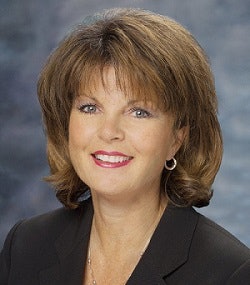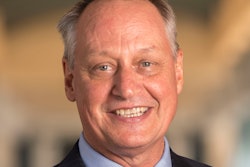On the heels of a new progress report on its Promise Program, the San Diego Community College District (SDCCD) is expanding the student success program to all first-time, full-time California high school graduates enrolling at the district’s colleges this coming fall.
With new state funding and continued donor support, the San Diego Promise Program will provide two fully funded years of college in addition to comprehensive support services — including counseling and tailored academic advising — to help students attain a certificate or degree, or transfer to a four-year college or university.
 Dr. Lynn Neault
Dr. Lynn Neault“What we’re incorporating for next year for our greatly expanded program is the requirement that the students who participate in the promise program complete a college readiness class,” said Dr. Lynn C. Neault, vice chancellor of student services for SDCCD. “It’s a three-unit class that includes education planning, time management, financial management and study skills, helping give students the tools they need to create a path, stay on the path and complete the path.”
SDCCD officials conducted and analyzed research on promise programs around the country to develop the structure of their own program in 2016.
“We looked at the programs and took what we believed were the best elements of all of them,” said Neault. Some of the components included using a “cohort model” for student support, having students participate in community service and setting a completion goal for students.
The district is looking to offer “wrap-around” services from community-based organizations in its program structure as the Promise Program builds out, Neault said.
The third year of the San Diego Promise Program will cost an estimated $1.86 million for the 2018-2019 year and be funded by state and non-state funds. This will allow the district to support 3,500 or more students through the program, district officials predict.
In its first and second year, the program served 186 students and 661 students, respectively, and relied on the district’s auxiliary funds and private philanthropy to support students.
Because more than 50 percent of students did not have to pay tuition even before the promise program, much of the program’s resources went to book grants, as “books can be as much as the tuition here in California because we do have relatively low tuition,” said Jack Beresford, director of communications and public relations for SDCCD.
Expectations and outcomes for students to complete their certificate, degree or to transfer will be the same, Neault added. Program eligibility requires a student to maintain a minimum 2.0 GPA, enroll in at least 12 units and complete a Promise commitment contract.
“We will provide the support services, the education planning, the follow-up [and] the monitoring of their progress to do everything we can to help them complete,” Neault said.
Concerns about the failure of many promise programs to support the underserved students for whom they were created largely has been resolved through SDCCD’s intentional program design, based on research and surveys on outcomes and needs for low-income students and students of color.
“We’re really strong believers in data-informed decisions,” Neault said. “Not only are we looking at the foundational outcomes data” — GPAs and eventually the number of students who earn degrees and certificates — “but we’ve also surveyed [students] and conducted focus groups to try to dig deeper into these behavioral things” affecting student success.
From the surveys and student focus groups in the first two years of the program, support staff learned that completing the 12 units can be a challenge for students with families or other responsibilities, and that students wanted more engagement from those who support them, Neault said.
“They want more reminders, they want more tutoring services, they want more engagement activities,” Neault said, “so that is where we are building the greatest strength in our program.”
The program is making strides in foundational outcomes for underserved students. According to the district’s 2017-2018 progress report on the San Diego Promise Program, the average GPA for an African-American Promise student was 3.3 — nearly a full point above the 2.37 average GPA of non-Promise, first-time, full-time students.
Additionally, 19 percent of San Diego Promise students had a 4.0 GPA compared to 12 percent of other non-Promise first-time, full-time students in the district. African-American and Latino Promise program students also had higher-course completion rates than all first-time, full time students.
This year, 25 Promise students will earn their degrees or transfer to larger four-year institutions.
“It doesn’t seem like a large number, but when you compare to the average time it takes community college students, that was a big feat,” Neault said.
The average time to degree for SDCCD students is seven years.
Part of the success of the San Diego Promise Program stems from the support of SDCCD faculty and others who donate to the program, many through payroll deduction, Beresford said.
Neault attributed the program’s expansion to the state of California’s investment in student success efforts over the last five years, and the California community college system’s “big vision” and mission for student success.
“So this is just a natural step in providing support structures and mechanisms to help students be successful,” she said.
As institutions scramble to bridge education and workforce opportunities, a new report by the San Diego-Imperial Center of Excellence for Labor Market Research found that “middle-skill” jobs make up an increasing portion of the labor market in the region.
As a result, the San Diego and Imperial Counties Community Colleges launched a campaign to prepare their students for the “well-paying, in-demand, middle-skill careers” through the message, “Learn More. Earn More.”
The campaign will highlight high-demand labor areas, including industrial machinery mechanics, healthcare support and computer-user support.
“To ensure our students are qualified for these job opportunities, we align our career education programs to meet the regional labor market demand,” said Dr. Sunny Cooke, superintendent and president of the MiraCosta Community College District. “We also have powerful partnerships with local employers to help students find their path and launch their careers.”
Tiffany Pennamon can be reached at [email protected]. You can follow her on Twitter @tiffanypennamon.



















